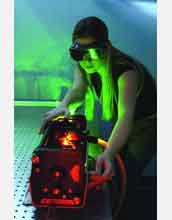Multimedia Gallery
ATE Centers (Image 10)
Students are educated in state-of-the-art labs at National Center for Optics and Photonics Education (OP-TEC) partner colleges. OP-TEC seeks to increase the supply of well-educated photonics technicians by building and strengthening the capacity and quality of photonics education in U.S. two-year colleges. [Image 10 of 12 related images. See Image 11.] (Date of Image: 2009)
More about this Image
The National Center for Optics and Photonics Education (OP-TEC) is a consortium of two-year colleges, high schools, universities, national laboratories, industry partners and professional societies funded by the National Science Foundation's (NSF) Advanced Technological Education (ATE) program (DUE 06-03275). The partners have joined forces to create a secondary to postsecondary pipeline of highly qualified and strongly motivated students, empowering high schools and community colleges to meet the urgent need for technicians in optics and photonics.
OP-TEC serves secondary science, technology, engineering and mathematics (STEM) programs and postsecondary programs devoted to lasers, optics and photonics technology or technologies enabled by optics and photonics. In addition, OP-TEC provides support through curriculum, instructional materials, assessment, faculty development, recruiting and support for institutional reform, and serves as a national clearinghouse for teaching materials; encourages more schools and colleges to offer programs, courses and career information; and helps high-school teachers and community and technical college faculty members develop programs and labs to teach technical content. OP-TEC is headquartered at the Center for Occupational Research and Development in Waco, Texas. To learn more, visit the center's website Here.
NSF's ATE program supports efforts to improve the knowledge and skills of technicians who work in high-technology fields that drive the nation's economy. The program focuses on undergraduates, secondary school students and incumbent technicians, as well as on the educators who teach them. Community colleges are the main providers of education for technicians and have leadership roles in all ATE initiatives, working closely with industry, government and educators in other sectors to enhance the skills of the men and women who are essential to the vitality of the nation's economy. ATE partnerships help create new curricula; reform existing programs; enrich the technical knowledge of experienced college faculty members and teachers; prepare prospective educators with solid foundations in STEM; and undertake applied research in technological education. Further information on NSF's ATE program is available Here.
Credit: Photo from ATE Centers Impact 2008-2010 (www.atecenters.org)
Images and other media in the National Science Foundation Multimedia Gallery are available for use in print and electronic material by NSF employees, members of the media, university staff, teachers and the general public. All media in the gallery are intended for personal, educational and nonprofit/non-commercial use only.
Images credited to the National Science Foundation, a federal agency, are in the public domain. The images were created by employees of the United States Government as part of their official duties or prepared by contractors as "works for hire" for NSF. You may freely use NSF-credited images and, at your discretion, credit NSF with a "Courtesy: National Science Foundation" notation.
Additional information about general usage can be found in Conditions.
Also Available:
Download the high-resolution JPG version of the image. (1.2 MB)
Use your mouse to right-click (Mac users may need to Ctrl-click) the link above and choose the option that will save the file or target to your computer.

